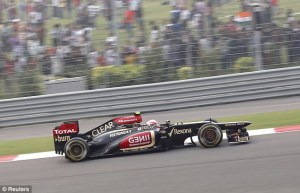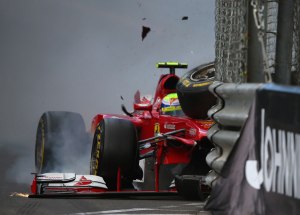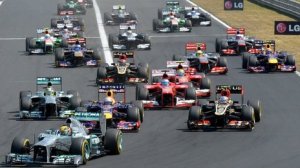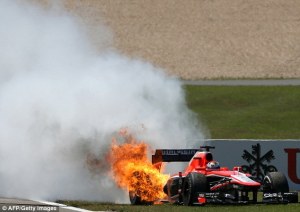It’s a case of another race, another win, and in this case another world drivers’ championship for Sebastian Vettel. Aside from the championship speculation the tyres had once again been a major talking point in India and there was some hope that the different strategies used would result in an exciting and unpredictable race. Unfortunately, that never really developed.
With Vettel starting on pole on soft tyres that only lasted a handful of laps and his Red Bull Racing team-mate starting in fourth on the harder compound, sandwiching the Mercedes cars of Nico Rosberg and Lewis Hamilton – both of whom were, like Vettel, starting on soft tyres – there was a fair degree of uncertainty about which of the Red Bulls would come out on top. In pure timing terms, Webber’s strategy was theoretically around two seconds faster over the course of the race. Added to this, Vettel’s strategy meant that he would have to overtake lots of cars as he came back through the field after stopping early to switch to the harder tyre. A great opportunity for Webber, it seemed.
Although, as expected, Webber did lead in India – breaking Vettel’s 100% record of laps led at the Buddh International Circuit – such was Vettel’s speed in getting through slower traffic that Webber never really stood a chance. Ultimately, of course, it wouldn’t have mattered if Webber had been Vettel’s equal in speed terms in India. Another failure on his car, this time an alternator meant that he retired from the race 20 laps from the end on lap 40.
While Vettel and Red Bull Racing made their strategy work perfectly by gearing their car aggressively so that the 26-year-old German was able to pass cars with relative ease, Mercedes certainly didn’t. In the end, though, it was a good day for the Silver Arrows; Rosberg’s second place and Hamilton’s sixth place finish enabled them to leapfrog Ferrari into second in the world constructors’ championship, which Red Bull also took in India.
The Mercedes drivers would never have been able to compete with Vettel for victory in India, but it was very telling that both of their drivers struggled badly to overtake cars after pitting. Vettel made it look easy, but Mercedes were just not fast enough down the straights. This meant that, having been overtaken by the Ferrari of Felipe Massa on the first lap, both drivers were then stuck behind him for most of the race. Rosberg made his way back ahead of the Brazilian using an undercut strategy at the second round of pit stops, but Hamilton, who stopped on the same lap as Massa, was unable to do likewise.
Despite outscoring both Ferrari and Lotus in India, Mercedes have to ask themselves some serious questions. Having started both cars on the soft tyre, the team would have known that they would have needed to overtake slower cars that started on the harder compound. Why they then decided to set their car up in a manner that did not facilitate overtaking is a mystery for me. We saw Hamilton, for example, stuck behind the Williams of Valtteri Bottas – which Vettel managed to breeze passed easily – for a number of laps at one stage of the race.
Ultimately, though, Mercedes did well to negotiate Rosberg ahead of Massa. This, coupled with a disastrous race for Fernando Alonso, who finished down in 11th place, unable to add to his record 1571 world championship points, meant that the Brackley based team moved ahead of the Scuderia in the constructors championship.
Lotus also did well to recover from a disastrous qualifying for Romain Grosjean to outscore Ferrari in India, meaning that it remains very much a three-way fight for that coveted second position in the constructors’ championship. Having badly misjudged things in qualifying meaning that Grosjean failed to make it out of Q1, starting down in 17th position, things looked bleak for Lotus at the start of the race. The Frenchman drove brilliantly, though, to take a place on the podium with a third place finish. Kimi Raikkonen’s seventh place finish certainly wasn’t quite as inspiring as he tried, and failed, to make a one stop strategy work. He did, though, at least have the satisfaction of snatching the fastest lap of the race away from Vettel on fresh tyres at the end of the race.
The final word goes to Vettel, though. A fourth consecutive Formula 1 world drivers’ championship at the age of 26 is certainly an amazing achievement. It does, though, make things a little dull for those that are not Vettel supporters. Vettel’s dominance, and the extreme role that tyre strategy is playing in modern Formula 1, is certainly dulling the spectacle. Radio messages such as the one from McLaren to Sergio Perez telling him not to fight Vettel due to their different strategies seem incompatible with the concept of racing, especially in a championship that’s meant to be the pinnacle of motorsport.
There’s hope that with a big regulation change coming next year, we may well see things mixed up a little in 2014. One thing’s for sure, though, if Red Bull Racing build another world-beating car, it’s all but certain to be world drivers’ championship number five for Vettel in 2014. I don’t know about you, but I find that an incredible depressing thought…
























